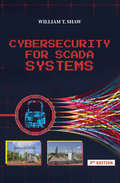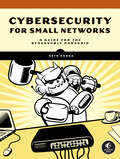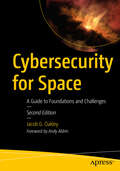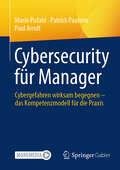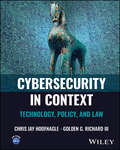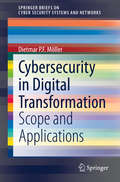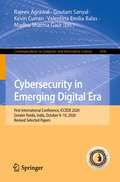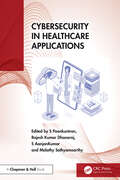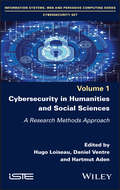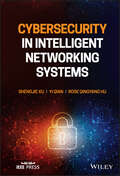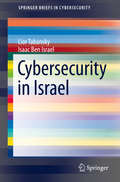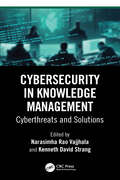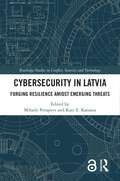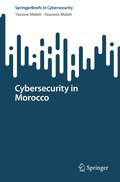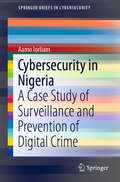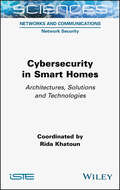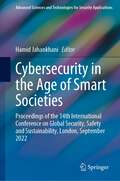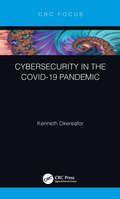- Table View
- List View
Cybersecurity for SCADA Systems
by William T. ShawThe world has changed since the first edition was published in 2006. There have been many technological changes in communications and networking and in other areas of computer science. More focus is given to implementing cybersecurity protections and technical countermeasures. The second edition also takes advantage of the evolved industry-specific cybersecurity standards that have emerged, especially in the electric power and oil-and-gas pipeline industry sectors. Cybersecurity for SCADA Systems, 2nd Edition is intended to provide a general background of SCADA system technology and cybersecurity concepts and technologies, showing how the two can be brought together to safeguard our infrastructure and computer automation systems. This book provides a high-level overview of this unique technology, with an explanation of each market segment. Readers will understand the vital issues and learn strategies for decreasing or eliminating system vulnerabilities. Cybersecurity for SCADA Systems, 2nd Edition is suitable for nontechnical, management-level personnel as well as IT personnel without SCADA experience. Features and Benefits Functional breakdown and explanation of the typical features, capabilities, and components of a SCADA system IT and cybersecurity technology and terminology overview and explanation Industry-specific as well as generalized discussion of SCADA vulnerabilities and available remediation strategies Discussion of physical and electronic security issues and strategies Audience IT personnel Management Students
Cybersecurity for Small Networks: A No-Nonsense Guide for the Reasonably Paranoid
by Seth EnokaA guide to implementing DIY security solutions and readily available technologies to protect home and small-office networks from attack.This book is an easy-to-follow series of tutorials that will lead readers through different facets of protecting household or small-business networks from cyber attacks. You&’ll learn how to use pfSense to build a firewall, lock down wireless, segment a network into protected zones, configure a VPN (virtual private network) to hide and encrypt network traffic and communications, set up proxies to speed up network performance and hide the source of traffic, block ads, install and configure an antivirus, back up your data securely, and even how to monitor your network for unauthorized activity and alert you to intrusion.
Cybersecurity for Smart Cities: Practices and Challenges (Advanced Sciences and Technologies for Security Applications)
by Mohiuddin Ahmed Paul Haskell-DowlandEnsuring cybersecurity for smart cities is crucial for a sustainable cyber ecosystem. Given the undeniable complexity of smart cities, fundamental issues such as device configurations and software updates should be addressed when it is most needed to fight cyber-crime and ensure data privacy. This book addresses the cybersecurity challenges associated with smart cities, aiming to provide a bigger picture of the concepts, intelligent techniques, practices and research directions in this area. Furthermore, this book serves as a single source of reference for acquiring knowledge on the technology, processes and people involved in the next-generation of cyber-smart cities.
Cybersecurity for Space: A Guide to Foundations and Challenges
by Jacob G. OakleySpace is one of the fastest growing military, government and industry sectors. Because everything in today’s world exists within or connected to cyberspace, there is a dire need to ensure cybersecurity is addressed in the burgeoning field of space operations. This revised and expanded edition will prime the reader with the knowledge needed to understand the unique challenges to space operations which affect the implementation of cybersecurity. Further, the reader will have foundational knowledge on what impacts cyber threats can have on space systems and how cybersecurity must rise to meet them. The author, who spent years in the United States Marine Corps, originally involved in satellite communications is now a seasoned cyber security practitioner who has provided cyber security vision and strategy to a large portfolio of systems and programs, many focused specifically in space. A published academic and experienced professional, he brings a practical, real-world and tempered approach to securing the final frontier. What You Will Learn Basic concepts of how different space vehicles operate in general. How such systems and their components integrate into cyberspace. A clear picture of the potential damage available via cyber-attacks to such systems. Basic efforts to mitigate such cyber threats will be presented through the various portions of space operations. Foundational issues at the intersection of the space and cyber domains Who This Book Is For This book is written for anyone curious about warfare in the era of cyber everything, those involved in cyber operations and cyber warfare, as well as security practitioners and policy or decision makers who are on the sending or receiving end of such activity.
Cybersecurity for Space: Protecting the Final Frontier
by Jacob G. OakleyThis is the first book of its kind to cover the unique challenges of creating, maintaining, and operating a system that operates in both outer space and cyber space. It covers the impact that cyber threats can have on space systems and how the cybersecurity industry must rise to meet the threats. Space is one of the fastest growing military, government, and industry sectors. Because everything in today’s world exists within or connected to cyberspace, there is a dire need to ensure that cybersecurity is addressed in the burgeoning field of space operations. You will be introduced to the basic concepts involved in operating space systems that include low earth orbit (LEO), geosynchronous orbit (GEO), and others. Using the related high-level constraints, threats, and vectors, you will be able to frame a clear picture of the need and challenges of bringing cybersecurity to bear on satellites, space vehicles, and their related systems. The author, who has spent seven years in the US Marine Corps and was originally involved in satellite communications and later cyber operations, is now a seasoned cybersecurity practitioner currently implementing cybersecurity vision and strategy to a large portfolio of systems and programs, many focused specifically in space. A published academic and experienced professional, he brings a practical, real-world and tempered approach to securing space vehicles and their systems. What You Will Learn Understand what constitutes a space system and the challenges unique to operations of all spacecraftGet introduced to various space vehicles and their unique constraints and challengesBe aware of the physical and cyber threats to the space vehicle and its ability to fly and orbitKnow the physical and cyber vectors from which threats may manifestStudy the micro- and macro-analysis provided of space system attack scenariosBe familiar with the high-level problems of cybersecurity in the space domain Who This Book Is For This book is written for two audiences: those with a background in space operations as well as those in cybersecurity. It offers the guidance needed to understand the unique challenges to space operations that affect the implementation of cybersecurity.
Cybersecurity für Manager: Cybergefahren wirksam begegnen – das Kompetenzmodell für die Praxis
by Mario Pufahl Patrick Paulsen Paul ArndtDieses Buch erklärt verständlich, was Cyber Security ist und wie Unternehmen der Bedrohungslage im Internet effektiv begegnen können. Entscheidungsträger erhalten leicht verständliche Denkanstöße und können sich anhand eines methodischen Rahmens Schritt für Schritt diesem zentralen Thema nähern und es besser durchdringen – die Voraussetzung, um gemeinsam mit IT- und Cyber-Security-Experten bessere operative Entscheidungen zu treffen. Die Bedeutung von Cyber Security nimmt von zu Tag Tag zu, da immer mehr Firmen gegen ihren Willen digital attackiert werden. Dies bringt das Thema auf den Tisch der Geschäftsführungen.In diesem Buch wird das Thema Cyber Security, das technisch sehr komplex und für IT-Laien schwer verständlich sein kann, auf eine verständliche Art und Weise dargestellt.
Cybersecurity in Context: Technology, Policy, and Law
by Chris Jay Hoofnagle Golden G. Richard III“A masterful guide to the interplay between cybersecurity and its societal, economic, and political impacts, equipping students with the critical thinking needed to navigate and influence security for our digital world.” —JOSIAH DYKSTRA, Trail of Bits “A comprehensive, multidisciplinary introduction to the technology and policy of cybersecurity. Start here if you are looking for an entry point to cyber.” —BRUCE SCHNEIER, author of A Hacker’s Mind: How the Powerful Bend Society’s Rules, and How to Bend Them Back The first-ever introduction to the full range of cybersecurity challenges Cybersecurity is crucial for preserving freedom in a connected world. Securing customer and business data, preventing election interference and the spread of disinformation, and understanding the vulnerabilities of key infrastructural systems are just a few of the areas in which cybersecurity professionals are indispensable. This textbook provides a comprehensive, student-oriented introduction to this capacious, interdisciplinary subject. Cybersecurity in Context covers both the policy and practical dimensions of the field. Beginning with an introduction to cybersecurity and its major challenges, it proceeds to discuss the key technologies which have brought cybersecurity to the fore, its theoretical and methodological frameworks and the legal and enforcement dimensions of the subject. The result is a cutting-edge guide to all key aspects of one of this century’s most important fields. Cybersecurity in Context is ideal for students in introductory cybersecurity classes, and for IT professionals looking to ground themselves in this essential field.
Cybersecurity in Digital Transformation: Scope and Applications (SpringerBriefs on Cyber Security Systems and Networks)
by Dietmar P.F. MöllerThis book brings together the essential methodologies required to understand the advancement of digital technologies into digital transformation, as well as to protect them against cyber threat vulnerabilities (in this context cybersecurity attack ontology is included, modeling different types of adversary knowledge). It covers such essential methodologies as CIA Triad, Security Risk, Likelihood, and Consequence Level, Threat Attack Profiling, Threat Intelligence, Threat Lifecycle and more. The idea behind digital transformation is to use digital technologies not only to replicate an existing process in a digital form, but to use digital technology to transform that process into something intelligent (where anything is connected with everything at any time and accessible and controlled and designed advanced). Against this background, cyber threat attacks become reality, using advanced digital technologies with their extreme interconnected capability which call for sophisticated cybersecurity protecting digital technologies of digital transformation.Scientists, advanced-level students and researchers working in computer science, electrical engineering and applied mathematics will find this book useful as a reference guide. Professionals working in the field of big data analytics or digital/intelligent manufacturing will also find this book to be a valuable tool.
Cybersecurity in Emerging Digital Era: First International Conference, ICCEDE 2020, Greater Noida, India, October 9-10, 2020, Revised Selected Papers (Communications in Computer and Information Science #1436)
by Valentina Emilia Balas Kevin Curran Rajeev Agrawal Goutam Sanyal Madhu Sharma GaurThis book constitutes selected and revised papers from the First International Conference on Cybersecurity in Emerging Digital Era, ICCEDE 2020, held in Greater Noida, India, in October 2020. Due to the COVID-19 pandemic the conference was held online. The 9 full papers and 2 short papers presented in this volume were thoroughly reviewed and selected from 193 submissions. The papers are organized in topical sections on cyber security issues and challenges in emerging digital era; security resilience in contemporary applications.
Cybersecurity in Germany (SpringerBriefs in Cybersecurity)
by Martin Schallbruch Isabel SkierkaIn 2016, Germany's government presented its third cybersecurity strategy, which aims to strengthen the national cyber defence architecture, cooperation between the state and industry, and individual users’ agency. For many years, Germany has followed/adopted a preventive and engineering approach to cybersecurity, which emphasizes technological control of security threats in cyberspace over political, diplomatic and military approaches. Accordingly, the technically oriented Federal Office for Information Security (BSI) has played a leading role in Germany’s national cybersecurity architecture. Only in 2016 did the military expand and reorganize its cyber defence capabilities. Moreover, cybersecurity is inextricably linked to data protection, which is particularly emphasised in Germany and has gained high public attention since Edward Snowden’s revelations. On the basis of official documents and their insights from many years of experience in cybersecurity policy, the two authors describe cyber security in Germany in the light of these German peculiarities. They explain the public perception of cybersecurity, its strong link with data protection in Germany, the evolution of Germany's cybersecurity strategies, and the current organisation of cybersecurity across the government and industry. The Brief takes stock of past developments and works out the present and future gaps and priorities in Germany’s cybersecurity policy and strategy, which will be decisive for Germany’s political role in Europe and beyond. This includes the cybersecurity priorities formulated by the current German government which took office in the spring of 2018.
Cybersecurity in Healthcare Applications
by Rajesh Kumar Dhanaraj S. Poonkuntran S. Aanjankumar Malathy SathyamoothyThe book explores the critical challenge of securing sensitive medical data in the face of rising cyber threats. It examines how artificial intelligence can be leveraged to detect and mitigate cyber threats in healthcare environments. It integrates advanced technologies such as AI security applications, blockchain techniques, cryptanalysis, and 5G security to strengthen the protection of healthcare systems. By offering insights into the latest vulnerability assessment technologies and effective protection strategies, this book serves as an essential resource for professionals and researchers dedicated to enhancing cyber security in the healthcare industry.
Cybersecurity in Humanities and Social Sciences: A Research Methods Approach
by Daniel Ventre Hugo Loiseau Hartmut AdenThe humanities and social sciences are interested in the cybersecurity object since its emergence in the security debates, at the beginning of the 2000s. This scientific production is thus still relatively young, but diversified, mobilizing at the same time political science, international relations, sociology , law, information science, security studies, surveillance studies, strategic studies, polemology. There is, however, no actual cybersecurity studies. After two decades of scientific production on this subject, we thought it essential to take stock of the research methods that could be mobilized, imagined and invented by the researchers. The research methodology on the subject "cybersecurity" has, paradoxically, been the subject of relatively few publications to date. This dimension is essential. It is the initial phase by which any researcher, seasoned or young doctoral student, must pass, to define his subject of study, delimit the contours, ask the research questions, and choose the methods of treatment. It is this methodological dimension that our book proposes to treat. The questions the authors were asked to answer were: how can cybersecurity be defined? What disciplines in the humanities and social sciences are studying, and how, cybersecurity? What is the place of pluralism or interdisciplinarity? How are the research topics chosen, the questions defined? How, concretely, to study cybersecurity: tools, methods, theories, organization of research, research fields, data ...? How are discipline-specific theories useful for understanding and studying cybersecurity? Has cybersecurity had an impact on scientific theories?
Cybersecurity in Intelligent Networking Systems (IEEE Press)
by Yi Qian Rose Qingyang Hu Shengjie XuCYBERSECURITY IN INTELLIGENT NETWORKING SYSTEMS Help protect your network system with this important reference work on cybersecurity Cybersecurity and privacy are critical to modern network systems. As various malicious threats have been launched that target critical online services—such as e-commerce, e-health, social networks, and other major cyber applications—it has become more critical to protect important information from being accessed. Data-driven network intelligence is a crucial development in protecting the security of modern network systems and ensuring information privacy. Cybersecurity in Intelligent Networking Systems provides a background introduction to data-driven cybersecurity, privacy preservation, and adversarial machine learning. It offers a comprehensive introduction to exploring technologies, applications, and issues in data-driven cyber infrastructure. It describes a proposed novel, data-driven network intelligence system that helps provide robust and trustworthy safeguards with edge-enabled cyber infrastructure, edge-enabled artificial intelligence (AI) engines, and threat intelligence. Focusing on encryption-based security protocol, this book also highlights the capability of a network intelligence system in helping target and identify unauthorized access, malicious interactions, and the destruction of critical information and communication technology. Cybersecurity in Intelligent Networking Systems readers will also find: Fundamentals in AI for cybersecurity, including artificial intelligence, machine learning, and security threats Latest technologies in data-driven privacy preservation, including differential privacy, federated learning, and homomorphic encryption Key areas in adversarial machine learning, from both offense and defense perspectives Descriptions of network anomalies and cyber threats Background information on data-driven network intelligence for cybersecurity Robust and secure edge intelligence for network anomaly detection against cyber intrusions Detailed descriptions of the design of privacy-preserving security protocols Cybersecurity in Intelligent Networking Systems is an essential reference for all professional computer engineers and researchers in cybersecurity and artificial intelligence, as well as graduate students in these fields.
Cybersecurity in Israel (SpringerBriefs in Cybersecurity)
by Lior Tabansky Isaac Ben IsraelThis SpringerBrief gives the reader a detailed account of how cybersecurity in Israel has evolved over the past two decades. The formation of the regions cybersecurity strategy is explored and an in-depth analysis of key developments in cybersecurity policy is provided. The authors examine cybersecurity from an integrative national perspective and see it as a set of policies and actions with two interconnected goals: to mitigate security risks and increase resilience and leverage opportunities enabled by cyber-space. Chapters include an insight into the planning and implementation of the National Security Concept strategy which facilitated the Critical Infrastructure Protection (CIP) agreement in 2002, (one of the first of its kind), the foundation of the Israeli Cyber-strategy in 2011, and details of the current steps being taken to establish a National Cyber Security Authority (NCSA). Cybersecurity in Israel will be essential reading for anybody interested in cyber-security policy, including students, researchers, analysts and policy makers alike.
Cybersecurity in Italy: Governance, Policies and Ecosystem (SpringerBriefs in Cybersecurity)
by Luigi MartinoThis book presents a detailed and innovative analysis of the governance, policies and ecosystem that define the Italian cybersecurity posture. It explores the complex interplay between technology and policy in shaping national security strategies in the digital era. The author introduces the reader to the critical importance of a policy-driven approach to cyber security, highlighting the challenges and necessary evolution prompted by rapid technological advancements and the expanding relevance of cyberspace. It emphasizes the multifaceted nature of cyber security that extends beyond technological solutions to encompass a broad socio-political analytical framework. The author also illustrates the need for an integrated approach that includes policies development, stakeholder engagement and strategic national objectives. This book delves into the organizational structure and dynamics of Italian national cybersecurity ecosystem, while shedding light on the collaborative interactions among different actors within this complex field. It meticulously outlines the roles and responsibilities of public, private and civil sectors in enhancing Italy’s cyber resilience. Key developments such as the establishment of the National Cybersecurity Agency and the formulation of strategic objectives to safeguard national cyber perimeter are critically examined. This examination not only reflects on the strategies employed but also on the challenges and achievements in fostering a robust cyber security environment able to respond to both current and emerging threats. Through a blend of theoretical insights and practical case studies, supplemented by more than 30 semi-structured interviewees. This book also offers a comprehensive overview of efforts implemented by Italy in 10 years of policy making experience with the aim to structure the appropriate cyber security national institutional architecture. It provides valuable perspectives on the effectiveness of these policies, the ongoing adjustments required to address the fluid nature of cyber threats, and the implications of these efforts on both national and international scales. Upper-under graduate level and graduate level students in computer science or students interested in cybersecurity will want to purchase this book as a study guide. Researchers working in cybersecurity as well as Policy Makers, Legislators, Decision Makers and CISO will also want to purchase this book as a reference book.
Cybersecurity in Knowledge Management: Cyberthreats and Solutions
by Narasimha Rao Vajjhala Kenneth David StrangIn an era where digital transformation is vital across industries, protecting knowledge and information assets has become critical. Cybersecurity in Knowledge Management: Cyberthreats and Solutions explores the intersection of knowledge management and cybersecurity, offering an in-depth examination of the strategies, technologies, and frameworks necessary to safeguard organizational knowledge systems. As cyber threats grow more sophisticated, particularly within sectors such as digital marketing, supply chains, and higher education, this book examines methods for enhancing cybersecurity while maintaining the agility needed to foster innovation. By incorporating perspectives from artificial intelligence, machine learning, and human factors, this work provides a holistic approach to securing knowledge in today’s interconnected landscape.This book includes an analysis of AI and machine learning applications for cybersecurity, a comparative review of malware classification techniques, and real-world case studies illustrating cybersecurity breaches and insider threats affecting knowledge ecosystems. This book addresses unique challenges within the African digital space, explores social engineering tactics, and emphasizes the role of organizational culture in maintaining knowledge security. Key topics include cybersecurity requirements in digital marketing, the post-COVID impact on knowledge transfer in higher education, and the importance of regulatory compliance and cross-industry collaboration.With its multidisciplinary perspective, Cybersecurity in Knowledge Management: Cyberthreats and Solutions is ideal for professionals, researchers, and policymakers. This comprehensive guide equips readers with the insights needed to build resilient cybersecurity programs that protect essential knowledge assets, enabling organizations to meet today’s cybersecurity demands while maintaining a sustainable competitive advantage in an evolving digital environment.
Cybersecurity in Latvia: Forging Resilience amidst Emerging Threats (Routledge Studies in Conflict, Security and Technology)
by Mihails Potapovs Kate E. KanastaDrawing on expertise from professionals, government officials, and academics, this book uncovers the proactive measures taken by Latvia to build resilient cybersecurity capabilities.The work offers a comprehensive exploration of Latvia’s cyber domain, structured around three overarching themes: the ecosystem, its processes, and future perspectives. In doing so, it takes readers through the intricacies of Latvia’s cybersecurity landscape and provides a nuanced understanding of its strengths, challenges, strategic considerations, and broader implications. One of the key contributions of the work lies in its exploration of Latvia’s cybersecurity strategies and resilience. By delving into the nation’s policies, collaborations, and technological advancements, this book uncovers how Latvia has proactively addressed cyber threats, emphasising the importance of tailored approaches for smaller countries in building robust cybersecurity defences. Highlighting the importance of studying cybersecurity in smaller nations, this book stresses Latvia’s contributions to global cybersecurity efforts as an EU and NATO member. The volume advocates for innovation and collaboration, emphasising their crucial role in securing a digital future for nations worldwide.This book will be of much interest to student of cybersecurity, Baltic politics, EU politics, global governance, and International Relations.The Open Access version of this book, available at http://www.taylorfrancis.com, has been made available under a Creative Commons Attribution-Non Commercial-Share Alike (CC-BY-NC-SA) 4.0 license.
Cybersecurity in Morocco (SpringerBriefs in Cybersecurity)
by Yassine Maleh Youness MalehThis SpringerBrief contains eight chapters and presents an overview of the evolution of the Moroccan Cybersecurity Strategy. It also draws attention to the development of cybersecurity in Morocco and to ensure national security in the context of the current and developing information confrontation in the international community. However, it cannot promise to provide an in-depth examination. The issue of cybersecurity is simply too wide-ranging for our purposes. This acknowledgment is meant to encourage more detailed research into the broader topics covered in this brief to better inform current approaches to national cybersecurity performance evaluation.This SpringerBrief targets researchers interested in exploring and understanding Morocco and its efforts in implementing its national cybersecurity strategy. This brief is also a relevant reference for diplomats, executives, CISOs, cybersecurity professionals and engineers working in this related field.
Cybersecurity in Nigeria: A Case Study of Surveillance and Prevention of Digital Crime (SpringerBriefs in Cybersecurity)
by Aamo IorliamThis book reviews the use of digital surveillance for detecting, investigating and interpreting fraud associated with critical cyberinfrastructures in Nigeria, as it is well known that the country’s cyberspace and cyberinfrastructures are very porous, leaving too much room for cyber-attackers to freely operate. In 2017, there were 3,500 successful cyber-attacks on Nigerian cyberspace, which led to the country losing an estimated 450 million dollars. These cybercrimes are hampering Nigeria’s digital economy, and also help to explain why many Nigerians remain skeptical about Internet marketing and online transactions. If sensitive conversations using digital devices are not well monitored, Nigeria will be vulnerable to cyber-warfare, and its digital economy, military intelligence, and related sensitive industries will also suffer. The Nigerian Army Cyber Warfare Command was established in 2018 in order to combat terrorism, banditry, and other attacks by criminal groups in Nigeria. However, there remains an urgent need to produce digital surveillance software to help law enforcement agencies in Nigeria to detect and prevent these digitally facilitated crimes. The monitoring of Nigeria’s cyberspace and cyberinfrastructure has become imperative, given that the rate of criminal activities using technology has increased tremendously. In this regard, digital surveillance includes both passive forensic investigations (where an attack has already occurred) and active forensic investigations (real-time investigations that track attackers). In addition to reviewing the latest mobile device forensics, this book covers natural laws (Benford’s Law and Zipf’s Law) for network traffic analysis, mobile forensic tools, and digital surveillance software (e.g., A-BOT). It offers valuable insights into how digital surveillance software can be used to detect and prevent digitally facilitated crimes in Nigeria, and highlights the benefits of adopting digital surveillance software in Nigeria and other countries facing the same issues.
Cybersecurity in Organisationen: Cyberangriffe in Österreich und Maßnahmen zu ihrer Bekämpfung und zur Prävention (essentials)
by Helmut SillerDieses Buch bietet einen Einstieg in die verschiedenen Formen, Ausprägungen und Folgen von Cybercrime und erläutert, wie Organisationen dieser Bedrohung begegnen können. Der Schutz vor Cybercrime in österreichischen Organisationen liegt in erster Linie in der Verantwortung der Unternehmensführung und der Mitarbeitenden. Professionelle Cyberprävention und Risikomanagement 2.0 werden zur Existenzfrage in jeder Organisation. Das Knowhow der IT wird im Cybercrime-Labyrinth damit (weiter) aufgewertet. Ziel von Organisationen muss sein, Awareness dafür zu schaffen und laufend zu aktualisieren sowie sich um Cyberresilienz zu bemühen. Hierfür bietet dieses essential eine grundlegende Hilfestellung.
Cybersecurity in Robotic Autonomous Vehicles: Machine Learning Applications to Detect Cyber Attacks
by Ahmed Alruwaili Sardar M. Islam Iqbal GondalCybersecurity in Robotic Autonomous Vehicles introduces a novel intrusion detection system (IDS) specifically designed for AVs, which leverages data prioritisation in CAN IDs to enhance threat detection and mitigation. It offers a pioneering intrusion detection model for AVs that uses machine and deep learning algorithms.Presenting a new method for improving vehicle security, the book demonstrates how the IDS has incorporated machine learning and deep learning frameworks to analyse CAN bus traffic and identify the presence of any malicious activities in real time with high level of accuracy. It provides a comprehensive examination of the cybersecurity risks faced by AVs with a particular emphasis on CAN vulnerabilities and the innovative use of data prioritisation within CAN IDs.The book will interest researchers and advanced undergraduate students taking courses in cybersecurity, automotive engineering, and data science. Automotive industry and robotics professionals focusing on Internet of Vehicles and cybersecurity will also benefit from the contents.
Cybersecurity in Smart Homes: Architectures, Solutions and Technologies
by Rida KhatounSmart homes use Internet-connected devices, artificial intelligence, protocols and numerous technologies to enable people to remotely monitor their home, as well as manage various systems within it via the Internet using a smartphone or a computer. A smart home is programmed to act autonomously to improve comfort levels, save energy and potentially ensure safety; the result is a better way of life. Innovative solutions continue to be developed by researchers and engineers and thus smart home technologies are constantly evolving. By the same token, cybercrime is also becoming more prevalent. Indeed, a smart home system is made up of connected devices that cybercriminals can infiltrate to access private information, commit cyber vandalism or infect devices using botnets. This book addresses cyber attacks such as sniffing, port scanning, address spoofing, session hijacking, ransomware and denial of service. It presents, analyzes and discusses the various aspects of cybersecurity as well as solutions proposed by the research community to counter the risks. Cybersecurity in Smart Homes is intended for people who wish to understand the architectures, protocols and different technologies used in smart homes.
Cybersecurity in Switzerland (SpringerBriefs in Cybersecurity)
by Myriam Dunn CaveltyGives the reader a detailed account of how cyber-security in Switzerland has evolved over the years, using official documents and a considerable amount of inside knowledge. It focuses on key ideas, institutional arrangements, on the publication of strategy papers, and importantly, on processes leading up to these strategy documents. The peculiarities of the Swiss political system, which influence the way cyber-security can be designed and practiced in Switzerland are considered, as well as the bigger, global influences and driving factors that shaped the Swiss approach to cyber-security. It shows that throughout the years, the most important influence on the Swiss policy-approach was the international level, or rather the developments of a cyber-security policy in other states. Even though many of the basic ideas about information-sharing and public-private partnerships were influenced by (amongst others) the US approach to critical infrastructure protection, the peculiarities of the Swiss political system has led to a particular "Swiss solution", which is based on the federalist structures and subsidiary principles, characterized by stability and resilience to external shocks in the form of cyber-incidents. Cybersecurity in Switzerland will be a stimulating read for anybody interested in cyber-security policy, including students, researchers, analysts and policy makers. It contains not only specific material on an interesting case, but also a wealth of background information on different variations of cyber-security, as well as on information-sharing and public-private partnerships.
Cybersecurity in the Age of Smart Societies: Proceedings of the 14th International Conference on Global Security, Safety and Sustainability, London, September 2022 (Advanced Sciences and Technologies for Security Applications)
by Hamid JahankhaniThis book provides an opportunity for researchers, scientists, government officials, strategist and operators and maintainers of large, complex and advanced systems and infrastructure to update their knowledge with the state of best practice in the challenging domains whilst networking with the leading representatives, researchers and solution providers. The ongoing pandemic has created a new level of threats which presents new challenges around privacy, data protection, malicious application, unprotected networks or networks with basic protection that are being used as a gateway to larger infrastructure with complicated architecture, and unintentional misuse such as those associated with algorithmic bias. All these have increased the number of attack vectors that can be used to attack such networks. Drawing on 13 years of successful events on information security, digital forensics and cyber-crime, the 14th ICGS3-22 conference aims to provide attendees with an information-packed agenda with representatives from across the industry and the globe. The challenges of complexity, rapid pace of change and risk/opportunity issues associated with modern products, systems, special events and infrastructures. In an era of unprecedented volatile, political and economic environment across the world, computer-based systems face ever more increasing challenges, disputes and responsibilities, and whilst the Internet has created a global platform for the exchange of ideas, goods and services, it has also created boundless opportunities for cyber-crime. This volume presents new materials and contribute to knowledge through the technological advances that are being made across artificial intelligence (AI), machine learning, blockchain and quantum computing. These technologies driven by a digital revolution are expected to be disruptive and provide major digital transformation in the way societies operate today. As result, although these advances provide social and economic benefits, but, also, provide new challenges that security industry need to raise their game to combat them.
Cybersecurity in the COVID-19 Pandemic
by Kenneth OkereaforAs the 2020 global lockdown became a universal strategy to control the COVID-19 pandemic, social distancing triggered a massive reliance on online and cyberspace alternatives and switched the world to the digital economy. Despite their effectiveness for remote work and online interactions, cyberspace alternatives ignited several Cybersecurity challenges. Malicious hackers capitalized on global anxiety and launched cyberattacks against unsuspecting victims. Internet fraudsters exploited human and system vulnerabilities and impacted data integrity, privacy, and digital behaviour. Cybersecurity in the COVID-19 Pandemic demystifies Cybersecurity concepts using real-world cybercrime incidents from the pandemic to illustrate how threat actors perpetrated computer fraud against valuable information assets particularly healthcare, financial, commercial, travel, academic, and social networking data. The book simplifies the socio-technical aspects of Cybersecurity and draws valuable lessons from the impacts COVID-19 cyberattacks exerted on computer networks, online portals, and databases. The book also predicts the fusion of Cybersecurity into Artificial Intelligence and Big Data Analytics, the two emerging domains that will potentially dominate and redefine post-pandemic Cybersecurity research and innovations between 2021 and 2025. The book’s primary audience is individual and corporate cyberspace consumers across all professions intending to update their Cybersecurity knowledge for detecting, preventing, responding to, and recovering from computer crimes. Cybersecurity in the COVID-19 Pandemic is ideal for information officers, data managers, business and risk administrators, technology scholars, Cybersecurity experts and researchers, and information technology practitioners. Readers will draw lessons for protecting their digital assets from email phishing fraud, social engineering scams, malware campaigns, and website hijacks.
